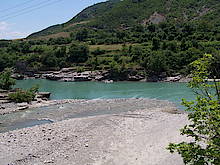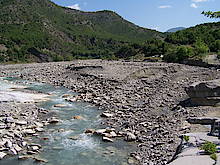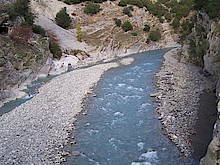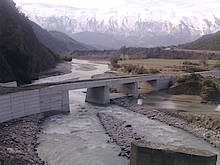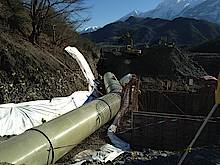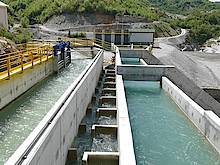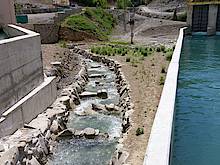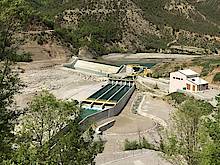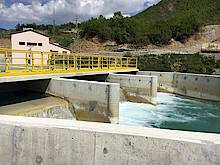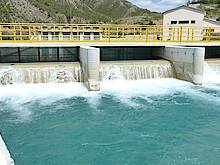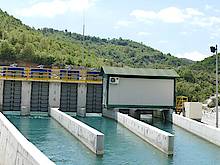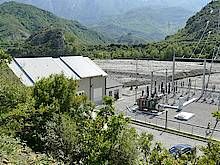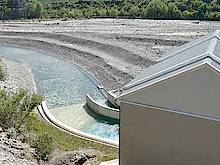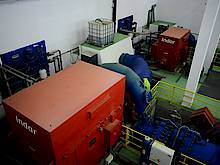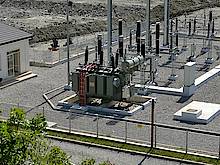Situated in the Gjirokaster province, in the Southeast of Albania, Lengarica power plant can draw on a relatively large catchment area of about 270 km2. The project is in operation since November 2015 and is scheduled to generate an annual production of 32,98 GWh with an installed capacity of approx. 9 MW.
Net head will come in at 148m. A headrace tunnel of 4 km length is used as a temporary reservoir to optimize production.
Project Scheme
The Tunnel as well as the pipeline are invisible because they are fully buried. Even the Forebay, connection point between tunnel and pipeline will be refilled and replanted after construction, so that in operation phase nothing will be visible from outside.
All for touristic purposes important and protected places are in severe distance and neither visible nor in other manner influenced by the project scheme.
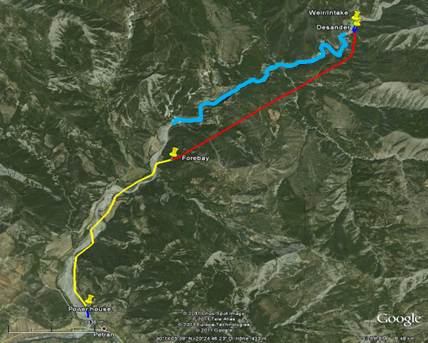
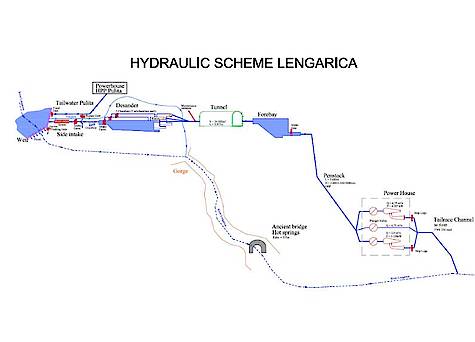
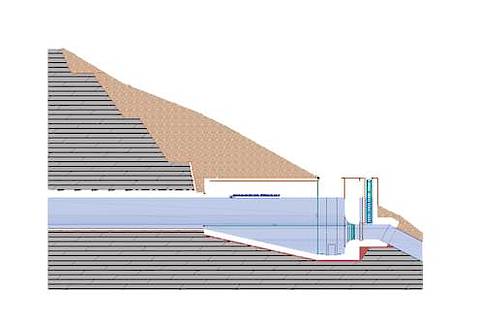
Design Criteria
- Respecting sensitive places (Hot springs, Canyon, Old Bridge)
- Respecting sensitive social and environmental elements (Irrigation needs, Fish Migration, Flora and Fauna)
- Invisibility of project elements (main elements under surface)
- Highest priority on reforestation and renaturation
- Additional element for improvement of ecological system (fish pass)
- Deep and wide investigation on every aspect before start of construction
- Focus on highest technical quality level for a sustainable and economic project (BOT - after operation period of 35 years the project will be transferred to public ownership)
History
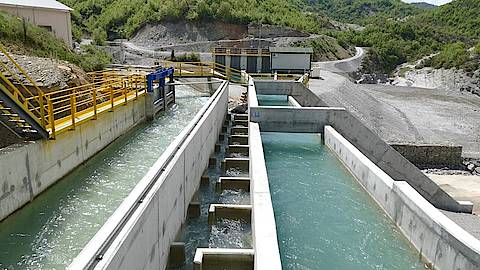
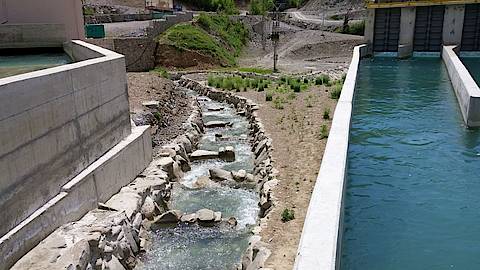
The concession for the HEPP Lengarica project was issued in 2008, before Hotovë was declared as National Park. enso acquired the project in 2010 from the Albanian project owner and improved the scheme in order to integrate the project into the sensitive area of the National Park in a smooth and invisible way. Special attention from the very beginning had been the invisibility of the project buildings, so almost everything is buried under ground after having the project put into operation.
Routing of the tunnel was very important and carefully designed, passing the National Monument “Lengarica Gorge” in a severe distance from the gorge and out of the vicinity from the hot springs “Benjë”.
Benjë, the hot springs, an important touristic attraction around and upstream of the famous ancient “Kadiut-Bridge” had been the second focus in the evaluation phase in order to ensure that the project doesn´t interfere with their discharge. It could be shown by hydrogeological studies and extensive measures, that the area from where the springs are sourced are not connected with the basin of the Lengarica river. This was a major criteria on the decision for project start.
The application for approval for the final project scheme was submitted in early 2011 to the authorities. Environmental permission therefore was finally given in 17.01.2012 after carefully check by Ministry of Environment and fulfillment of the request for supplementary documentation and reports. In order to ensure fulfillment of international requirements for ESR (Environmental and Social Responsibility) enso engaged ERM (ERM GmbH - Environmental Resources Management - International Experts) to develop an extended ESAM (Environmental and Social Action and Monitoring Plan) which goes far beyond the local requirements at that time. Within these ESAM every aspects (environmental and social responsibility) which are part of international standards have been considered and investigated by additional studies in order to have a certified program for design, construction and operation of the HEPP Lengarica in place.
As an outcome of the deep studies enso decided to install a fish pass at the intake weir and included adoption of the construction procedure (e.g. not allowing night traffic to avoid disturbance of the possible migration of big carnivores).
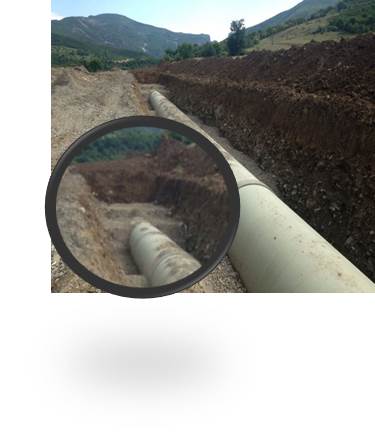
In 2012 IFC joined the Albanian Holding "enso hydro energji sh.p.k." as an equity shareholder. The project was checked again on conformity with the IFC Performance Standard.
It was our utmost concern to have excellent relationship with the involved landowners and surrounding villages and communes. Despite the Albanian Law provides an opportunity to get land from the state on certain programs enso followed from the very beginning the way of friendly negotiation with landowners for the use of their land during construction and during operation. As 100% of construction on private land will be under ground in operation, all land can be used right after finishing of construction and renaturation as it was used before. Private landowners are compensated even beyond European level for the land use by Lengarica&Energy sh.p.k.
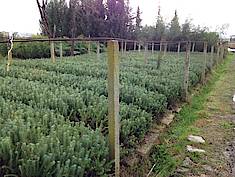
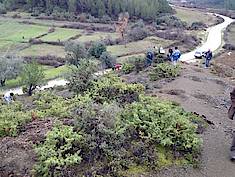
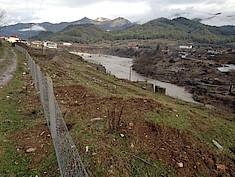
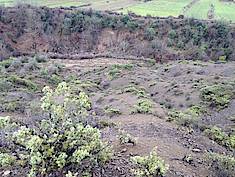
Detailed rehabilitation plans for all and even minimal aversive used areas are part of the project discussed in detail with the Ministry of Environment and local Forest Authorities.
More than that, Lengarica&Energy sh.p.k. agreed also on additional compensation measures and has already reforested previous karstic areas outside of the project area with 45.000 plants. Forest department of Permet determines the areas for replanting. These measures support the renaturation of local areas, destroyed by previous uncontrolled misuse in the past.
Additional support of national reforesting program is under preparation together with the Ministry of Environment.
Studies & Reports
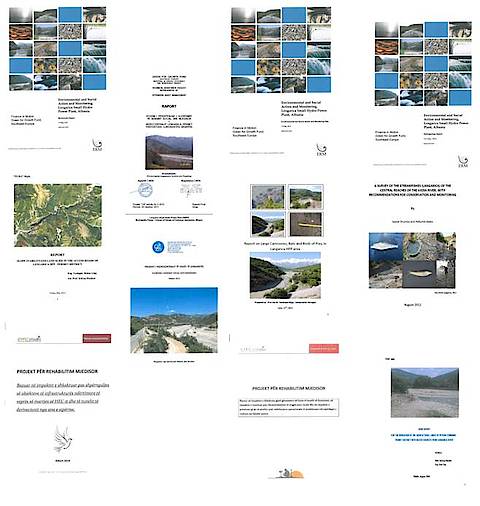
All studies, investigation and reports executed for the project are public available at the office of Lengarica & Energy sh.p.k. Meetings with Experts can be organized and they are principally always available for raised questions and explanations.
- EIA Report, 2011
- Environmental and Social Action Monitoring Plan (ESAM), 2012, ERM (This is the main document and the summarization of all studies and procedural handbook and therefore available even in the commune)
- Biodiversity Report, 2012, ERM
- Hydrogeology Report, 2012, ERM
- Report on large carnivores, bats and birds, 2012, Prof. Bego
- Assessment of fish species, 2012, Prof. Shumka
- Study of Impact on Visibility, 2013, QKZH
- Irrigation Report, 2013, ELBA
- Evaluation study on slope stability and landslide risk, 2013, ELBA
- Rehabilitation Report, 2014, EMC
- Hydrogeological – Thermal Springs, 2012, Aquaterra
Monitoring Programm
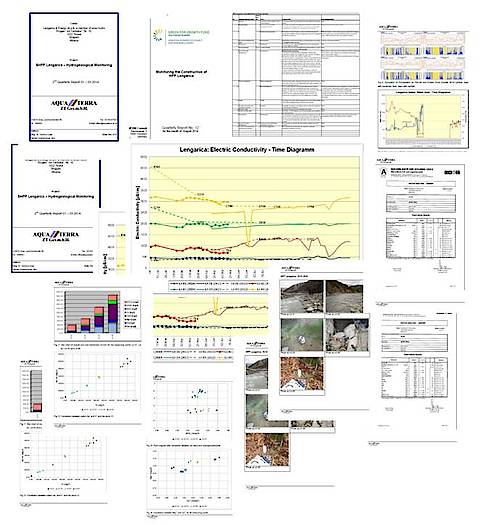
During Construction
- Monthly Monitoring of Fulfillments of ESAM Requirements (ERM, Germany, on behalf of GGF)
- Monthly Monitoring of Project Implementation (Technical, Commercial)(ENERM, Germany, on behalf of GGF)
- Site visits and Monitoring AKBN
- Site visits and Monitoring IFC
- Site visits and Monitoring National Environment Agency
- Site visits and Monitoring EMC (on behalf of MoE)
- Daily/Monthly Monitoring of Hydrogeology/hot springs
- Daily Measurements of turbidity, flow, water temperature, electric conductivity, ph-value
- Submission of water samples to international accredited Austrian institution for Evaluation of chemical parameters
Ongoing
Ecological flow monitoring:
- Site visits and Monitoring IFC
- Daily Measurements of turbidity, flow, water temperature, electric conductivity, ph-value
- Fish Monitoring
Reporting
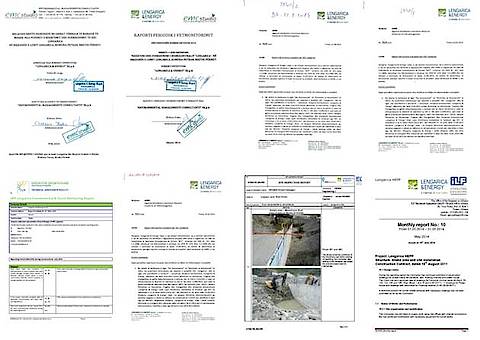
During Construction
- Quarterly Reporting to AKBN, Tirana
- Quarterly Reporting to Regional Agency of Environment, Gjirokaster
- Quarterly Reporting to National Environment Agency, Tirana
- Monthly Reporting to ERM (ESAM)
- Monthly Reporting to GGF (Green for Growth Fund)
Ongoing
- Quarterly Reporting to AKBN, Tirana
- Reporting to Financing Institution (Intesa Sanpaolo Bank Albania)
Site Supervision & EHS (Environmental Health and Safety)
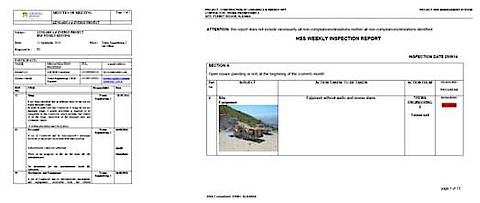
During Construction
- Permanent Monitoring of construction works on site (ILF, international company; quality + Health & Safety IFC standards)
- Weekly, Monthly and Quarterly Reporting by ILF
- Permanent Monitoring of Fulfillment of Health and Safety Requirements on site by an external expert (ERMC, international company)
- Weekly Reporting by ERMC
- Regular Training and Training Supervisory Program for all involved companies and persons
Ongoing
- Permanent Monitoring of Fulfillment of Health and Safety Requirements on site
- Regular Training and Training Supervisory Program for all involved companies and persons
Social Local Activities/Benefits
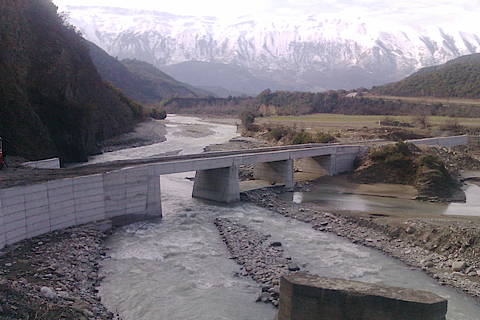
- Local Representative located in Permet (CLO)
- 24 Hours Availability for enquiries and concerns
- Permanently in contact with local authorities, landowners and all other stakeholders
- Providing Infrastructure Projects
- Erecting of massive bridge across Lengarica (access to villages)
- Road Rehabilitation of more than 14 km roads
- Erecting of local roads
- Erecting of culverts and small bridges
- Elaboration of irrigation studies for the local commune
- Contractual Agreement with the local commune for providing sufficient water for irrigation purpose during plant operation
- Consequent avoidance of the instrument of expropriation in all land issues and fair compensation for landuse (no single complaint)
- Supportive Involvement in water supply and waste water system project in Permet
- Reconstruction of ancient mill
- Rehabilitation of Kadiut-Bridge
- Support in geological assessment of orthodox church
Grievance Redress Mechanism
LENGARICA has established a Grievance Redress Mechanism (GRM). This is to ensure that anyone with a complaint or concern about the LENGARICA Project activities can tell us and get feedback from us on how the company will address this concern or issue.
This mechanism is established recognizing the importance of transparency and accountability. The concerns and complaints of project-affected people and other stakeholders can be freely made and will be addressed in a manner that is fair, objective and constructive.
LENGARICA will review all grievances that are submitted. If LENGARICA finds that a grievance is not related to LENGARICA activities or if the Project is in compliance with the Albanian and International Standards that LENGARICA is committed to, we will explain this to you in writing.
If LENGARICA finds that the subject of the grievance is a result of LENGARICA activities and does not comply with LENGARICA’s Environmental and Social commitments, we will investigate the issue and contact you to suggest and agree on an appropriate resolution. LENGARICA will handle your grievance as confidential.
Reporting a Grievance
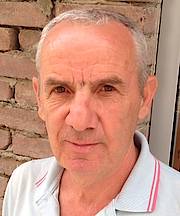
You can report a grievance to us by:
- Send a letter to our offices
- Contact LENGARICA in person, through email or on the phone
The CLO (Community liaison officer) Mr. Agron Ibrahimi can be reached under following contact:
Feedback will be provided to you.
Mechanism´s Core Steps
1. REGISTRATION OF COMPLAINTS
When we register your Grievance, we will proceed to process it. Complaints should be in writing. After registering your complaint it shall be processed through the Grievance Redress Mechanism.
2. ACKNOWLEDGEMENT OF COMPLAINT
Your complaint will be acknowledged in written within 15 days. This is to confirm that your Grievance has been registered and is being processed through the LENGARICA GRM. The Acknowledgement will inform you also on the grievance nr, contact person, the process and the estimated time line for the complaint resolution.
3. GRIEVANCE RESOLUTION
LENGARICA designated Units will review your complaint. Within 30 days of acknowledging your complaint we will contact you to either provide our resolution or to give an update on the grievance status.
4A. APPEAL
If you are not satisfied with the solution provided by LENGARICA, you have the possibility to file an appeal for review of your case by LENGARICA. The complaint may also be freely taken to any other alternative level of redress outside of LENGARICA.
4B. AGREEMENT
If you are satisfied with the LENGARICA’s proposed solution we will ask you to sign an agreement statement to this effect to formalize the corrective actions to be executed by LENGARICA to resolve the Grievance.
5. SOLUTION IMPLEMENTATION
After reaching an agreement for the Grievance resolution, LENGARICA shall implement the agreed corrective actions.
Grievances you can raise
You can raise a complaint or concern with LENGARICA if you believe that the Project has had or is having a negative effect on you or your household.
Example of grievances could include, but are not limited to:
• Consequences of the project or project activities negatively influencing your everyday life;
• Negative effects on a person, household or community group (e.g. financial loss, loss of resource, physical harm);
• Criminal activity;
• Financial malpractice, impropriety;
• Attempts to conceal any of the above

